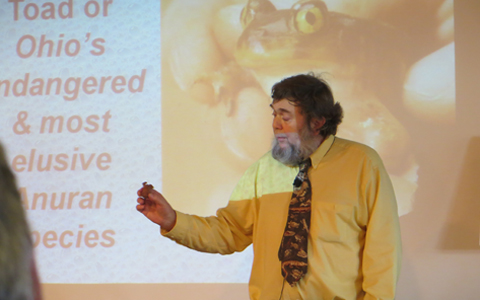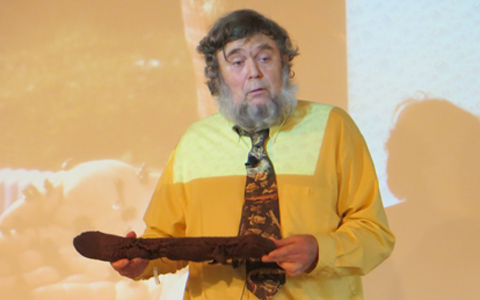“We timed this just perfectly. Do you know what’s going to happen tomorrow? Do you know what’s happening today?” asked Dr. Scott Moody at the Feb. 19 Science Café as temperatures rose outside.
“All those frogs and salamanders are just sticking their noses out. They are sensing the increasing temperature. Their bodies are no longer frozen under the soil. Warm rain is going to trickle in tomorrow. Actually they started getting those cues several weeks ago as the days were getting longer. That started to trigger their hormones. The eggs are already produced. The males are producing sperm. Tomorrow will be the beginning of all of the choreographing of all the behaviors and sounds so that those sperm and eggs can get together and make the next generation,” said Moody, Associate Professor of Biology in the College of Arts & Sciences and Curator of the Vertebrate Zoology Collections at Ohio University.
“That’s what’s going to happen tomorrow night (Thursday, Feb. 20),” said Moody. Be on the lookout for the relatives of the tiger salamander.
“We have two here in this area, one known as Jefferson’s salamander, it’s a large bluish-gray salamander. The other being the spotted salamander. They are the ones that are going to emerge out of all the woodlands and the hills, probably tomorrow night, and they’re going to go back to the pool where they were born. It might be a quarter mile away.
A #2 Pencil Crawling Across the Road
“They’re going to have to cross roads. So tomorrow night or any wet rainy night in February and March, if you’re driving the local roads, and you happen to see something that looks like a #2 pencil crawling across the road, stop and look and it’s probably a Jefferson salamander or a spotted salamander.
How do you find the frogs? “The good thing about frogs is they are all acoustical,” Moody said. “When they’re in the breeding season, the males are making sounds to defend territories and attract females.”
Moody started frog calling surveys about 20 years ago, enlisting the help of resident and high school students assigned take tape recorders on particular routes.
“It was amazing how much new information we got. Some counties where we didn’t know a particular species lived we finally got documentation,” said Moody, who has studied extirpated (no longer existing at a local level), endangered and threatened amphibian populations.
The OHIO Hellbenders, Instead of the Bobcats?
Moody held up a preserved Hellbender—a huge salamander more than a foot long and the largest salamander in North America—that used to be prominent in the clear-waters of the Hocking River but now is on the Ohio Endangered Species List. Moody makes the case that the Hellbender should have been and the Ohio University mascot instead of the bobcat. (The Hellbender is included on the mural on the walkway under the Richland Avenue Bride.)
Also on the Ohio state endangered list is the spadefooted toad. Moody began studying the toad in 1986 at the request of the Ohio Department of Natural Resources “because this guy had not been seen anywhere in the state for years and years.” The first population described in the state in a science journal was in Athens, OH, in 1943. The site of the Athens population is now a shopping center on East State Street and was the original Ohio University airport.
Knowing the habitats in which to search, Moody did find populations of the toad, starting in Belpre in 1987. When the Belpre field was developed for housing, Moody rescued and raised about 15,000 tadpoles and relocated them in an appropriate new habitat in Athens County. Watch the Science Café video at Livestream (http://new.livestream.com/ohiocas/events/2714695) to see where Moody’s toads might have ended up.
‘Why Their Survival Is Vital to Our Health’
Moody titled his Science Café talk “Endangered Species of Amphibians: Why Their Survival Is Vital to Our Health” because of his studies of the dynamics of population change and the effect of herbicides (such as atrazine) used on corn and soybean fields.
“We’ve seen drops in the amphibian populations just in the last 20 years, and we are now documenting the impact of those same herbicides on human health.”





















Comments